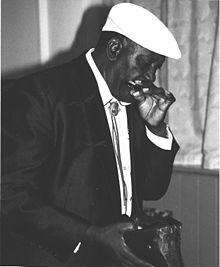Snooky Pryor
| Snooky Pryor | |
|---|---|

Pryor in Edinburgh, June 1993 (photograph: Phil Wight)
|
|
| Background information | |
| Birth name | James Edward Pryor |
| Born |
September 15, 1919 or 1921 Lambert, Mississippi United States |
| Died | October 18, 2006 (aged 85-87) Cape Girardeau, Missouri, United States |
| Genres | Chicago blues,Delta blues |
| Occupation(s) | Musician, carpenter |
| Instruments | Vocals, blues harp, bugle |
| Years active | 1945–2006 |
| Labels | Vee-Jay, Virgin, ABC, Blind Pig, Telarc, Electro-Fi |
James Edward "Snooky" Pryor (September 15, 1919 or 1921 – October 18, 2006) was an American Chicago blues harmonica player. He claimed to have pioneered the now-common method of playing amplified harmonica by cupping a small microphone in his hands along with the harmonica, although on his earliest records in the late 1940s and early 1950s he did not utilize this method.
Pryor was born in Lambert, Mississippi, and developed a Delta blues style influenced by both Sonny Boy Williamson I (John Lee Williamson) and Sonny Boy Williamson II (Aleck Ford "Rice" Miller). He moved to Chicago around 1940.
While serving in the U.S. Army he would blow bugle calls through a PA system, which led him to experiment with playing the harmonica that way. Upon discharge from the Army in 1945, he obtained his own amplifier and began playing harmonica at the outdoor Maxwell Street Market, becoming a regular on the Chicago blues scene.
Pryor recorded some of the first postwar Chicago blues, in 1948, including "Telephone Blues" and "Snooky & Moody's Boogie", with the guitarist Moody Jones, and "Stockyard Blues" and "Keep What You Got", with the singer and guitarist Floyd Jones. "Snooky & Moody's Boogie" is of considerable historical significance: Pryor claimed that harmonica ace Little Walter directly copied the signature riff of Pryor's song in the opening eight bars of his blues harmonica instrumental "Juke," an R&B hit in 1952. In 1967, Pryor moved to Ullin, Illinois. He quit music and worked as a carpenter in the late 1960s but was persuaded to make a comeback. He was later rediscovered by blues fans and resumed recording occasionally until his death in nearby Cape Girardeau, Missouri, at the age of 85.
...
Wikipedia
